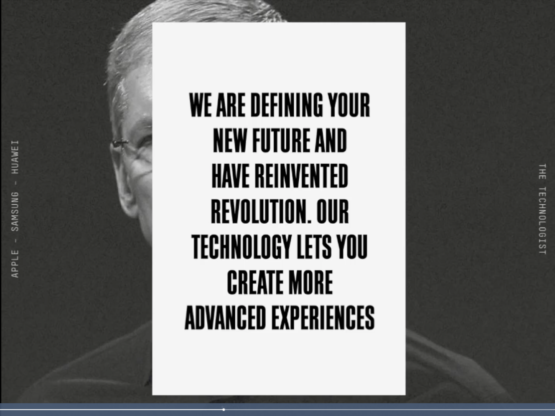Evaluation of Work & Personal Objectives
INTRODUCTION
– Develop a substantial body of new work
– Sets the scene for your future career direction
– Self-led
– Project evolves with the rigour and depth
– Research or theory led, or personally or professionally orientated.
Critical and Contextual Report
– Key theory and research underpinning your work
– Identify, approach and connect with academic and industry peers in order to gain critical feedback and insights
– Networking and making your own connections
Phases follow the double diamond framework
Formative Feedback
– In Week 4 you have to submit a project draft summary for your tutor review
– In Week 8 you have to present a case study to a panel for review
– In Week 13 (the first week back after the break) you submit a draft written sample of your critical report
Blog
– Demonstrate deeper critical reflection of your thinking and working processes
– Elaborate on ideas, findings and visual experiments
– Reflect on the discussions raised in webinars and crits
– Analyse how feedback has informed your creative direction
Lectures (Weeks 1-2)/Case Studies
– Understand the context of developing a practice-led research project
– Practice-themed: offering key insights from a project’s conception to delivery
- Theory-themed: approaches that your critical report could take, offering key insights into form and approach
Advice
Map out a personal working schedule:
– With deadlines for formative and summative assessment
– Work through stages sequentially
– Allow time for research, development, experimentation, testing and final production.
Know your field:
– Immerse yourself in your final project theme.
– Become aware of others also working in areas linked to this field
– Extend your research into real-world contexts, seeking dialogue with experts
Be strategic:
– How will this lead to new opportunities in your career?
Share your learning (Peer to Peer):
Share your research, development, prototyping, testing, process and production
Be open:
To surprises, mistakes, feedback, risk-taking, problem-solving and connection-making
Ethics:
– Complete an ethical review before starting your research (to be submitted with your project proposal in Week 4)
– Make sure you are asking the right questions and following the correct procedures from an ethical standpoint in relation to your project idea
– Document on your blog
– Highly considered part of your project!
Weekly learning outcomes:
LO2: Contextualise - Appraise the social, political and historical contexts in which design practice operates
LO3: Analyse - Evaluate research findings and use sound judgement that is informed by critical debate at the forefront of the academic discipline
LO5: Imagine - Deliver appropriate and innovative ideas that embrace risk, have contemporary relevance and question the boundaries of the discipline
LO6: Make - Select and utilise relevant tools, skills and technologies in the delivery, iteration and sustainable production of an outcome
LO8: Design - Realise a final solution that evidences its strategic journey and clear relationship between form and function
LO9: Communicate - Communicate effectively in a range of contexts and situations to specialist and non-specialist audience
LO10: Manage - Demonstrate applied planning and organisational skills to support self-directed project work and inform ongoing professional development needs.
…
PHASE 1: RESEARCH & DISCOVER
– Develop and refine your project brief and research question, following a review of your work to date
– Outline the contextual positioning and reasoning for your chosen approach
– Revisit resources
– Revisit individual research and reference material
...
WEEKS 1-2: - REVIEW: EVALUATION OF WORK & PERSONAL OBJECTIVES
– Identify your area of research and investigation
– Identify a clear research question
– Create a personal plan
Develop a clear research question with aims, objectives, purpose and audience:
– How might you investigate your research question?
– What else is happening / has happened historically in your chosen area of research?
– What connections can you make?
– What research methods might you deploy?
– What is your position in relation to your chosen area of research and how will this project benefit you?
– Who is it for? Define your audience
– Is my project going to be research academic and theory led?
– Is my project going to be professionally or personally orientated?
—
PRACTICE LECTURE NOTES
Practice-themed: offering key insights from a project’s conception to delivery
ALEC DUDSON: PUBLISHING ACROSS MULTI-PLATFORMS
Working as an intern himself and understanding and empathising with the nature of the challenges young people face when 'employed' in this way; Alec set up intern magazine with one core business construct in mind:
'To empower people, regardless of their background, to build their careers within the creative industries with diversity and industry at its core.'
With a background in sociology Alec employs an immersive ethnographic approach to his independent print publication. This was 'born out of the need to create dialogue in exploring the nature of internships'. The format was originally that of a physically printed magazine but due to costs (printing, distribution, retail etc.,) has largely moved to an online model.
Launched using crowd funded money from Kickstarter its timing couldn't have been better placed as the discussion was front and centre with a case in the US that was brought by interns working on the movie 'Black Swan'.
The online purchase model has also led to a maximisation of profit due to reduced distribution costs and enabled Alec to look at additional revenue streams in sales of the physical magazine, of prints and other materials such as totes etc. It also allowed for an immersive experience for the user. The business has grown organically and has evolved into career focussed education, consultancy, public speaking events, podcasts, film production and event management all within the framework of building support structures for creatives. At their core in the development of these projects is the use of young creatives who are paid properly for the work they produce whether illustrators, designers, film makers, music producers or artists.
It is important for Alec to stay true to the core belief that interns should be respected and paid accordingly for their efforts and that the presentation of these values is also present when working with third parties and brands. He only works with brands that align with the nature of the business and his core beliefs and all advertising is given a uniform approach so as not to take away from these core values. Developing these relationships has enabled him to grow the business with additional revenue streams.
TAKE OUTS
– Define your area of interest
– What is your core mission and values?
– Define your audience. Who is it for?
– Is there a social need or political, environmental and cultural standpoint for doing this?
– What currently exists in this space?
– Is there a need, niche or gap to be filled?
– Ask yourself how you will achieve this?
– What is your vision plan for the future?
– How will you research the topics or questions raised?
– Define who you need to work with to make this a reality
– Who are your collaborators/stakeholders?
– What are your key roles?
– How do you monetise and build revenue to fund this?
– Who can you gain funding from that align with your core values?
...
JOE POCHODZAI: DESIGN FOR SOCIAL CHANGE
In Joe's lecture he asks the question 'how do we use design as a tool for transformation considering social and political points of view?'.
He views the practice of graphic design as a discipline that can challenge traditions and effect change which informs, inspires, and influences the socio-political landscape. It is his core belief that design led practice is no longer in a position to isolate itself from cultural, political, environmental or societal shifts, asking the creative practitioner to consider what it is we are doing within the field of design and why we are doing it? 'This is not targeted at a designer's own discipline or practice, but at social and political phenomena' Ramia Mazé/2009).
His practice is data driven using an ethical ethnographic approach in engaging with the 'public, places, communities and individuals' to unpack specific societal issues, using research as a tool to effect change by understanding historical archive data, language, voices, and user experiences. He believes to effectively 'amplify and communicate... voices needs radical strategies and careful attention.' At its core lies the practice of noticing the ignored to find new insights, patterns and truths. This quantitive contextual gathering of data is then presented back to its audience in the form of participatory workshops or immersive events. The purpose of these is to add new voices to the process with the end goal of providing tools that empower communities to continue to effect change long after the designer's have removed themselves from the process.
Using the 'amplified' voice, his outcomes typically take the form of publication's or immersive events which are the result of community engagement and capture the data and perspectives gathered. He asks the designer in conducting this kind of research that you need observe, consider voices and language of others, consider ethics and apply your own values and understanding into the mix taking a personal position on the material gathered and work produced. It is also key to consider the results of a participatory project of this scale and whether or not your goals have been achieved. Did you effect change and empower the community you embedded yourself in?
TAKE OUTS
– What is it we are doing with our role within design and why are we doing it?
– Can we use design as a transformational tool to effect change within our own practice?
– What are your intentions, goals in the creation of this work?
– What is your stance/position?
– How will you work within a community and what are the ethics involved?
– How do you engage with communities to understand a specific societal or political issue?
– How do you gather data: Through archives, artefacts, language, voices and user experiences? Workshops/events?
– Who will you collaborate with to make this happen?
– How can you use the data effectively to see patterns and implement 'radical strategies' for enacting a plan/vision?
– How do you provide the tools for a community to continue to effect change?
– Is there a way you can use your own experience, story, values and understanding?
...
BEN EVANS JAMES: ACADEMIC CREATIVE PRACTICE
In Ben's lecture he discusses his own process and approach to writing academic papers unpacking the level of detail you should consider in your own practice. He starts by asking us to create a research question that cannot be answered with simple yes or no answers and that as a result of this we should place ourselves in the position of questioning what we know. This helps us to find new areas of insight and produce work that answers an original question and/or aims to solve a particular problem.
He conducts a deep dive into how a document can be structured, whether by creating a set of ordered chapters: Contextual Review, Research, Practice and conclusion verses an approach that prioritises research first and contextualises at the end. The first approach allows for sequential chapters with the main topics you want to cover with a narrative that makes sense. However, both approaches are subject to structuring that aids the reader and manages their expectations within a given text.
He stresses the importance of having a high end start that will engage the reader from the outset and continue their interest throughout the written piece. These can be in the form of summaries or sub questions that lead the reader into the text and capture your audiences interest. His process is to write, iterate, conclude by reflecting on the given subject and highlights that this is an ongoing process of review and refinement until the work is completed.
As part of this process he defines the difference between writing descriptively vs being critically analytical with an emphasis on the importance of critical analysis which is rooted in facts, identifies the significance of why something happened, its importance, why something works, and creates patterns and reference points between key pieces of information. Critical analysis is based on reasoned judgements in your own conclusions and that taking a stance or position on your own authorship is essential.
He unpacks in the need to avoid writing opinion pieces stressing that you should write with arguments stating your position in order to gain new insights or to uncover new perspectives. He also asks us to avoid retelling a story using a 'he said, she said' approach and that we should use signal verbs that match the action.
TAKE OUTS
– What is your research question and does it require analysis?
– How do you contextualise this question into a structured contextural review?
– What are the key chapters/subjects you want to cover?
– Create a high end start for continued reader engagement
– Write with a narrative that makes sense
– Be critically analytical basing your writing in fact and not personal opinion
– Write with argument - what is your position and are there facts/insights that can support your argument?
– Return to your key question and points made within the text
– Use signal verbs that point to an action
– Write, iterate, conclude and reflect as part of your process
– Be grammatically correct
– Be precise in retelling the information
Ask yourself end of project questions:
– What did I do?
– Why did I do it?
– What happened?
– What do the results mean in theory?
– What do the results mean in practice?
– What are the key benefits for someone engaging with this project?
– What remains unresolved?
...
ROBERT GREEN: REDISCOVERING A LOST TYPEFACE (Design Craft)
The BBC documentary on Robert Green's journey in sourcing the origins of The Dove Press typeface is one of research, discovery, the unpacking of myths made real and finding new insights when redrawing the font from punch cut examples itself. The typefaces multiple idiosyncratic variations in letterforms made the redrawing of the typeface an almost impossible task and Robert's 'obsession' to create a true version of the original led him deeper into understanding the fonts origins through archival material, diaries, location and the recovery of the original metal type itself which was dumped into the Thames after a protracted dispute between the presses partners. With years passing and the realisation that a clear reconstruction of the font was hampered by the multiple printed variations and a limited amount of material recovered from the river; Robert finalised his own version in 2015. The 147 pieces of metal type recovered from the Thames are now on loan to the Walker Emery Estate giving the general public a window into the Dove Press and the font's troubled history.
TAKE OUTS
– Use archives, diaries and contemporary stories in undertaking research
– Who were/are the parties involved
– Are their any discoveries or insights to be uncovered?
– Are their any locations that add significance in the retelling of your story?
– Are there any parties that would be interested in the outcome of your research findings?
—
THEORY LECTURE NOTES/TAKE OUTS
THEORY LECTURE 1/THEORISED MAKING (BEN EVAN JAMES):
— Consider the medium/media and how your audience will view it.
— What is the narrative structure?
— What is the audience journey (Navigation, engagement and hierarchy)?
— Parafictions can be used to reveal facts/truths about the times we live in. These are "Fictions that artists or designers introduce into the world as facts." Carol Lambert
— When creating a parafiction an audience should be able to discover what is or isn't true.
— A documentary approach is usually informed by personal representation and fiction
— Engage with different mediums/media.
— Your practice should be a direct response to your research.
— Co-creation/collaboration adds richness to your research.
— Your research should be a direct response to your research question.
— The act of making adds to your research and can reveal new insights.
— Define your theme/approach.
— Is it necessary for your audience to engage with the work on a visual and verbal level?
— Is there a user journey?
...
THEORY LECTURE 2/RESEARCH LED REPORT: TOWARDS A WORKERS ENQUIRY (SUZANNA EDWARDS, CHRIS LACEY & BETH WORTH).
— Critical discourse and reflection important.
— Ethnographic approaches used by both in the study of the industry.
— What is your place within the industry and how do you operate within it?
— Unionised design is based in craft based practice.
— Your design report is a first person narrative analysis of your subject matter (with or without contextualising with questions).
— Ethnographic (human) experience often reveals more than pure statistics.
— What already exists within your field of study. Where are the gaps/patterns?
— How do you investigate your own place/position within the industry?
— Where are we going and how do we plan for the future?
— Statistics and data is constantly changing and tends to out of date by the time of publication - especially where statistics are concerned.
— Contextualising data (Ethnographic and Stats) builds a richer, deeper analysis of your field of study.
— Create a wider context: Conversations, first hand experience, interviews etc.,
— A wider context creates a picture of your narrative: Family, working conditions, updaid work vs paid, perceptions etc.,
— How did you get here and what is your working practice?
— Who are the participants being surveyed?
— Are they relevant to your research?
— What change can you effect?
— Who is going to continue to drive this change? (Responsibility and ownership).
— Understand the environment you are moving into.
— Who will fund this work? Stakeholders such as Institutions, Universities etc.,
— Address structural inequalities or conditions.
— Be truthful and transparent about what these changes could potentially mean.
— Is membership of a union necessary?
— Explore different industries/experiences.
— How can you intervene in real spaces to expand the conversation and effect change?
...
THEORY LECTURE 3/PROFESSIONAL STUDIO/CREDENTIALS ORIENTATED/REPORT (ALEC DUDSON)
— Clients are our audience when creating presentation documents.
— Make your decks easily accessible. (Open access).
— The interactive and digital space is becoming ever more important.
— A project proposal deck can be non-visual (HAWRAF example).
...
THEORY LECTURE 4/BUSINESS PLAN (ALEC DUDSON)
— Business plans are used mainly for securing funding and for presenting entrepreneurial ideas.
— Executive summary (synopsis of your business, your customers and why existing businesses fail to meet their needs).
— How is your business different? (USP).
— How would you describe your company/practice? What is your mission statement? (Business purpose and intent).
— What is your company history?
— Are you purpose driven and responsive to changes in the world?
— Use SMART.
— Market research: What are the customers you expect to have?
— Look at 3 sector case studies. What are their character traits? Who is their intended audience? What brands do they work for?...
— Competitor analysis: Who is in your space? What do they look like? What do their services cost? What is the percieved value?
— Ask others within your industry.
— What are your products or services? What are its benefits? What processes do you employ? What does the team look like? What are your overheads and expenses? Do you have repeat custom/client retention built in?
— Marketing and sales strategy: Summarise your value proposition, target markets, customers. A targeted markey=ting strategy can be used to lanch, grow and retain clients. Cost up where your offering will be seen (Social, TV, Websites, Press etc.,).
— Business Financials: Include your income, profit and loss, balance sheets, cashflow forecasting , invoice terms, net income, liquidity (how much of your money is available).
— Organisation and management: Who are your team members? What are your credentials? How do they bring value? (Experience, awards, companies worked for).
— Funding requests: Be clear about how the money will be spent. Be specific and transparent.
— Appendix: Keep investors requests, licences, IP, legal documentation, tax details, memberships and accreditations.
...
WEEKS 1-2: - REVIEW: EVALUATION OF WORK & PERSONAL OBJECTIVES
Identify your area of research and investigation
Since intermitting last year I have been interested and observing the speed at which AI is being implemented within creative practice whether to write proposals, for gathering data, for creating pitch decks or for research purposes (Chat GPT). It is also starting to be used for design iteration and implementation processes (Adobe Firefly, Midjourney, Dali E). This has raised several questions for me personally such as: What are the advantages/disadvantages of using AI in creative practice? How can we best integrate AI into our practice? At what point does the creative take control of the process in producing original work? Should AI be used at all by creatives? Do creative industry jobs need safeguarding from advances in AI? and Does design need a code of practice for using AI?
Both Nutella and Heinz have used AI to iterate designs but how close are the results to answering the given client brief, meeting market concerns and aligning with and engaging a target audience?
As part of this project I would also like to explore the origins of AI from Alan Turin's original papers on the subject to the present day, its history and development. I think it is a rich subject area, my main concern being that my findings will be out of date by time of submission. I am also interested in experimenting with various AI tools to really discover how limited or powerful as tools for creatives they really are.
Craig Oldham's 'They Live' project is also a source of inspiration for me; not so much in the work itself (which is great), but in the way he has created a narrative structure linking each area of interest. The format lends itself to including historical, ethnographic, interview based content and a variety of perspectives in a chapter based format.
In terms of how this can be applied to my own practice my areas of interest are culture, the arts, and design for the music industry. I think the content gathered, prototypes and experiments and visual stimulus could lead to a multitude of outcomes that would have a broad appeal to audiences interested in culture. However, I am too early in my own process to unpack what form these take and ultimately how they can align with my practice or be made real.
Identify a clear research question
Initial question (to be edited and refined as I delve deeper into my research):
How will AI shape the future of graphic design practice?
Revisiting resources & course progression in creating a personal plan
REFLECTIONS 0N GDE710-GDE740 LEARNINGS & RESOURCES
In reading through my submitted work and blog posts to date I was pleasantly surprised in how much I have grown through this process and the amount of information I have retained and implemented into my daily practice. However, I think my greatest failure has been in areas such as collaborative and ethnographic practice.
—
In reviewing this body of work I have highlighted some areas which will be may be implemented as part of my process:
PHILOSOPHICAL STANDPOINT:
Philosophy: Empirical (rational and fact based)
Methodology: Epistemology - Theory of knowledge itself (origins, validity, methods, scope and limitations)
Ethics (Axiology):
– The ethics of collaborate/ethnographic practice
– The ethics of AI: Social, Political, Cultural, Technological, Environmental
– Codes of practice
...
OBJECTIVES:
– What are my aims, meaning and purpose for creating/curating this work?
– What will the project effect/change?
...
RESEARCH (Areas for investigation):
– Origins
– The cultural landscape
– Economics
– The social landscape
– The political landscape
– The cultural landscape
– The technological landscape
– Environmental concerns
– Competitive Landscape: Who is working in this field of interest?
Resources: Libraries, Online, Archives, Research Bodies etc.,
...
DATA GATHERING (Quantitive Research without using Bias):
– Data Sets
– Fact Based Stats
– Context
– Trends
– Personas
– Research Bodies
– Analytics
– Interviews
– Questionnaires
– SWOT Analysis
– Case Studies
This data could be presented in the form of editorial, image and/or information graphics
...
COLLABORATIVE PROCESS:
– Stakeholders: STEM, Data Analylists, Statisticians, Colleagues
– Co-Creative Process
– Fundraisers
– Feedback
...
VISUAL WRITING:
– Compelling Narratives/Storytelling
– Elevator Pitch
...
ITERATION (Speculative/Non-Speculative)
– Research, Design and Prototyping
– Risk Management: SWOT Analysis
– Mood Boards
– Design Iterative Process
– Prototyping
– Application
...
FINANCE
– Does the project require funding?
– Is their potential to monetise the project?
– Cost Analysis
...
METRICS
– Effectiveness
– Reflections and Conclusions
...
Ask yourself, how might you investigate your research question?
DRAFT MIND MAP EXPLORING POTENTIAL AVENUES FOR RESEARCH
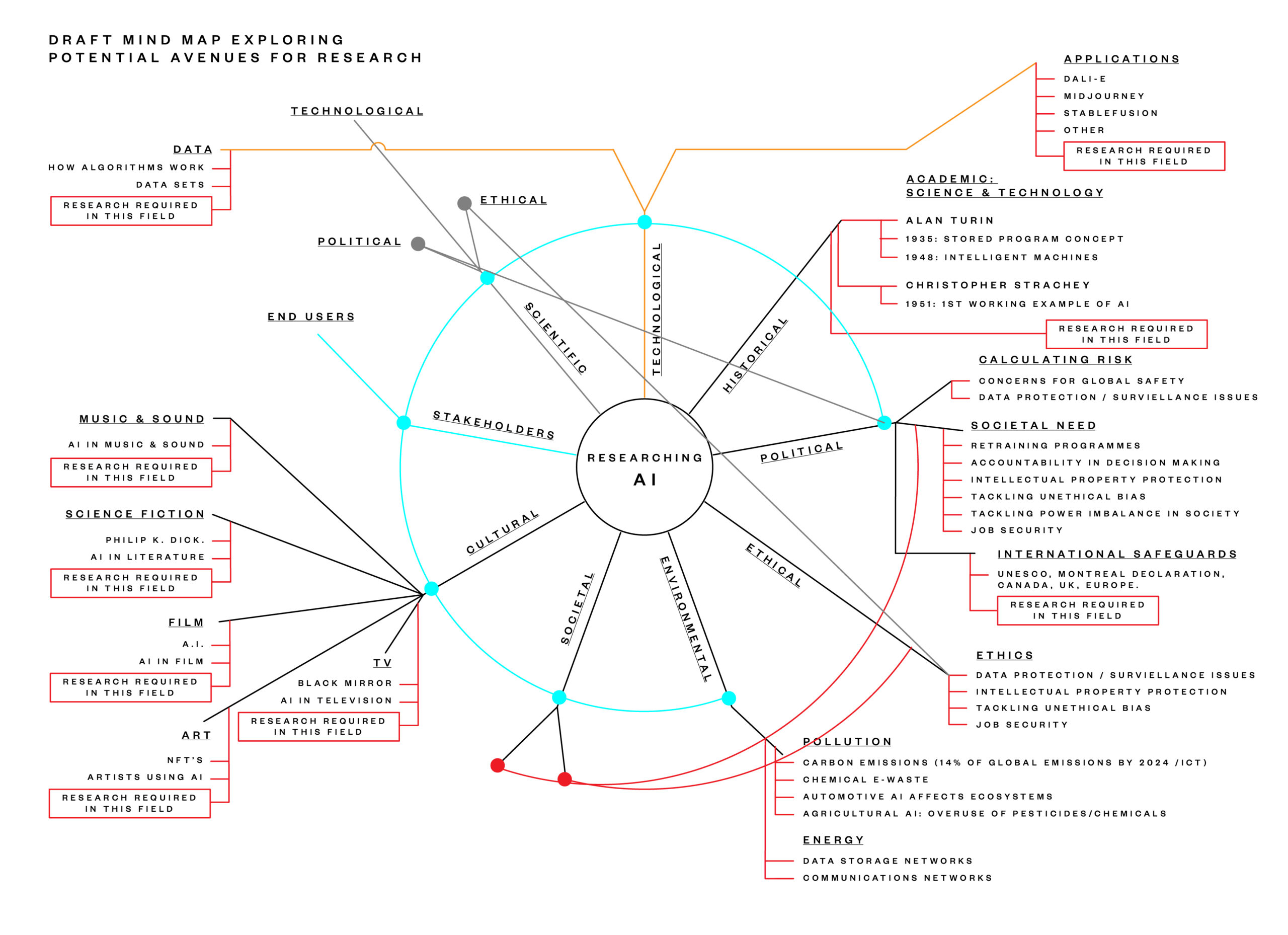
...
Personal Plan
In this draft plan I have tried to capture my intentions for moving forward although this may be subject to change as part of my progress.
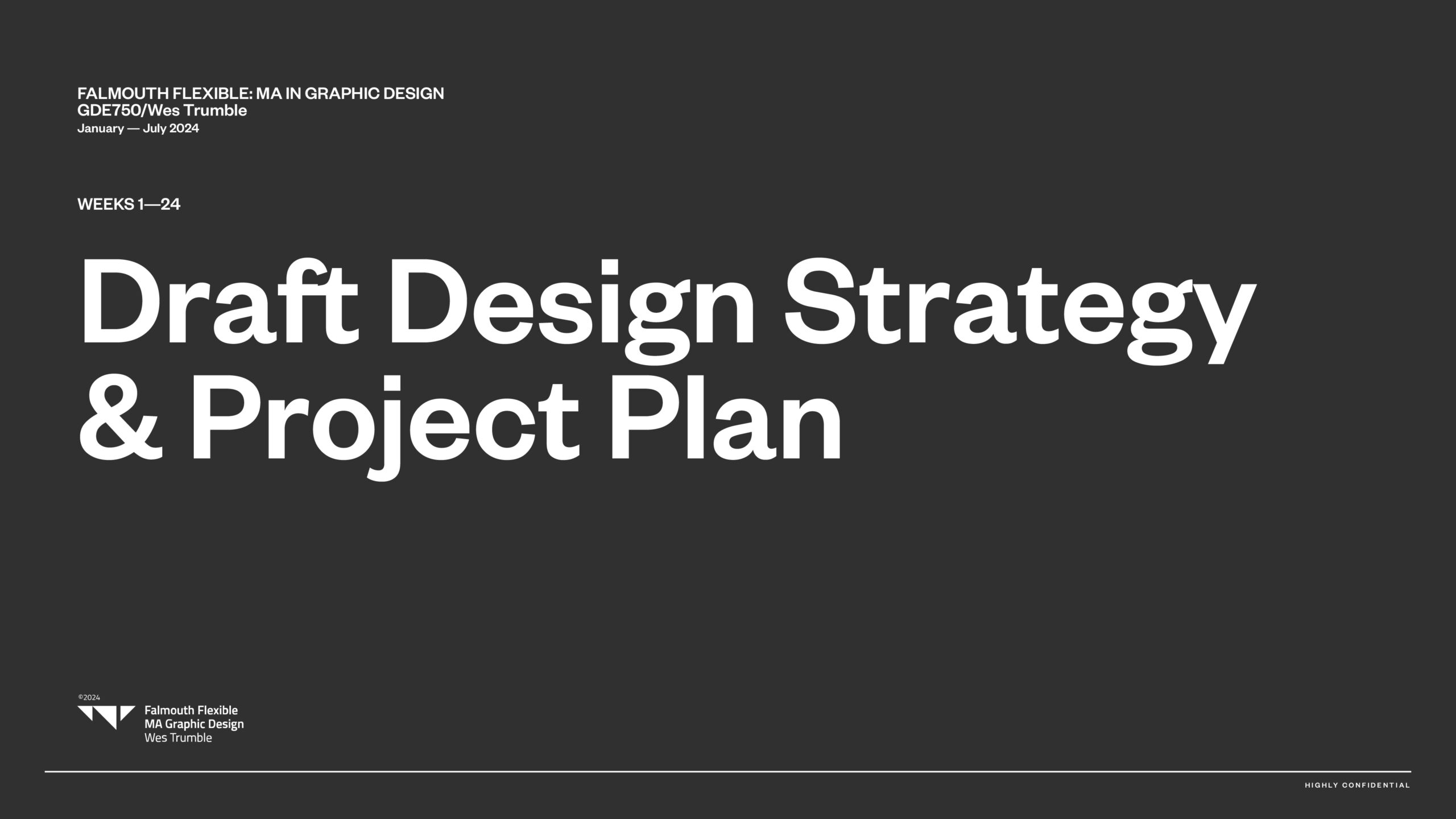
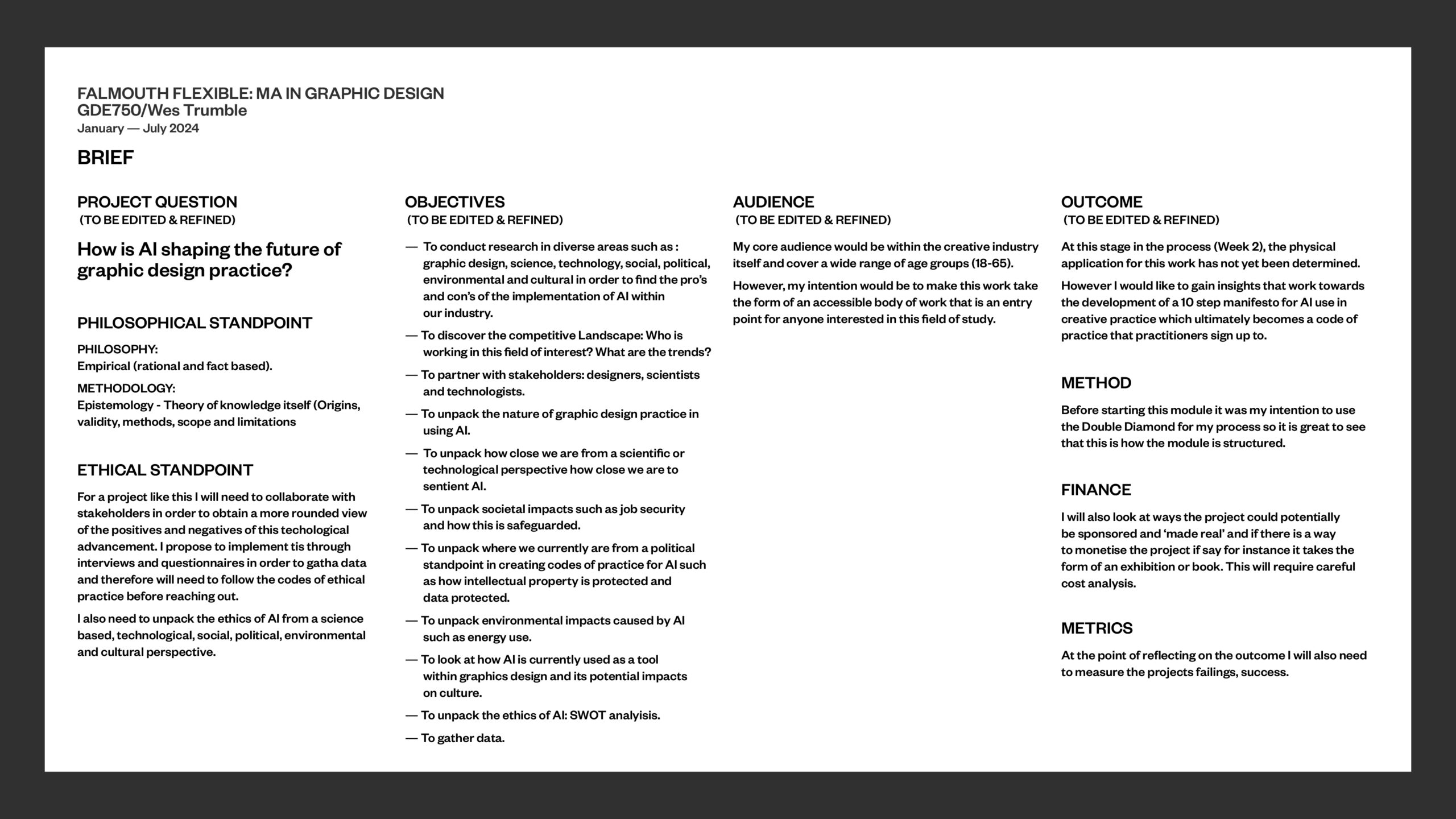
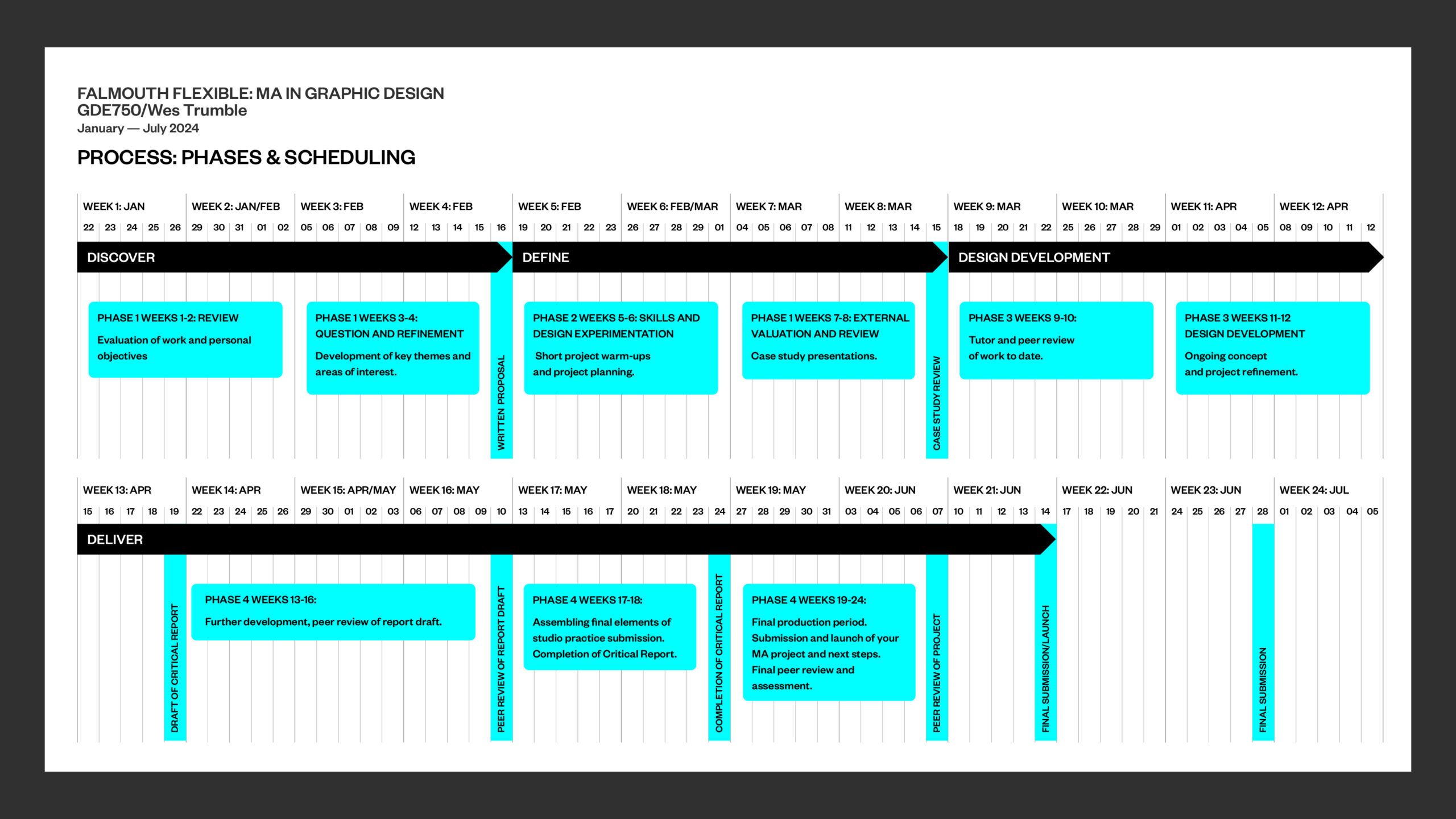
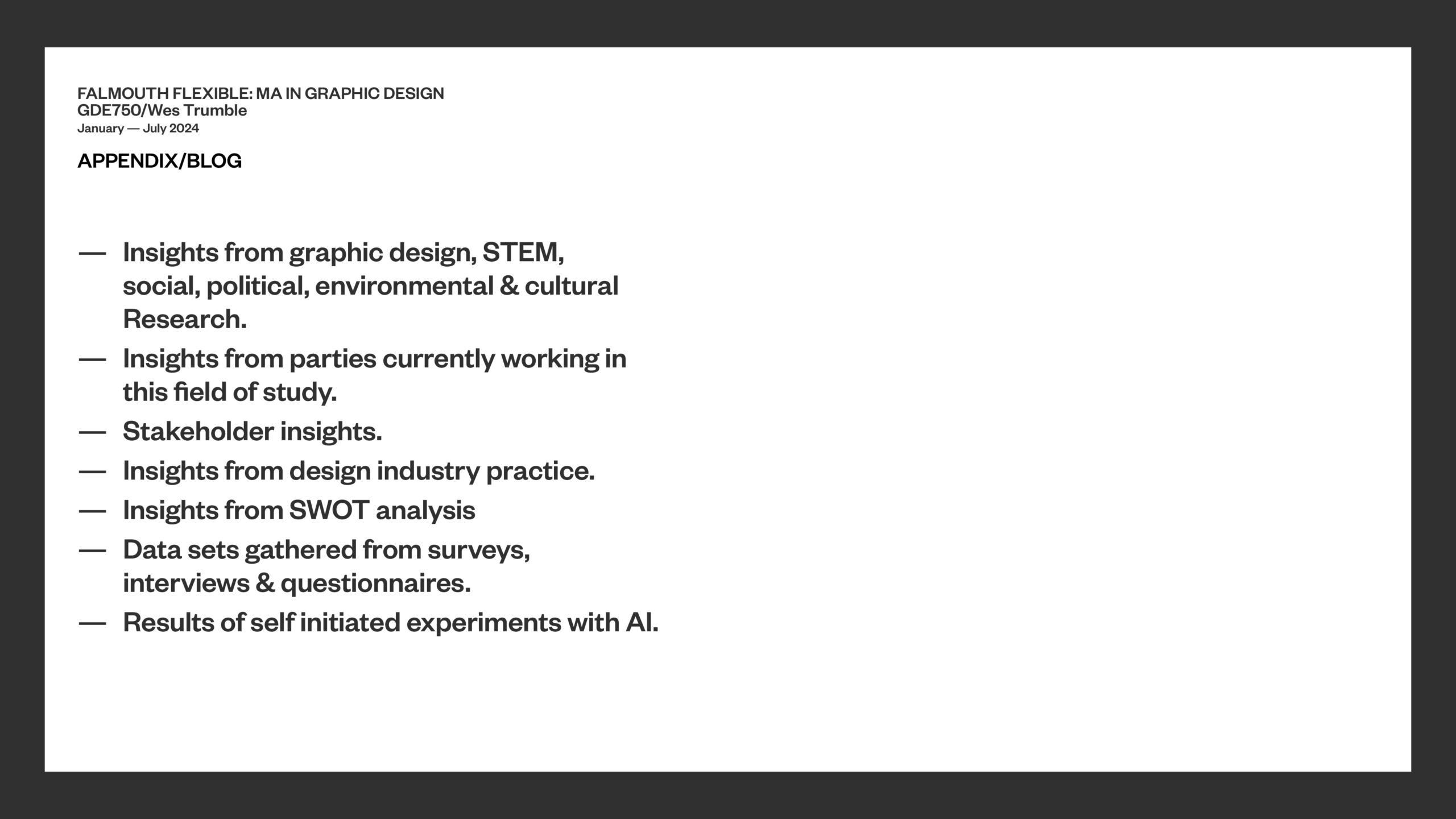
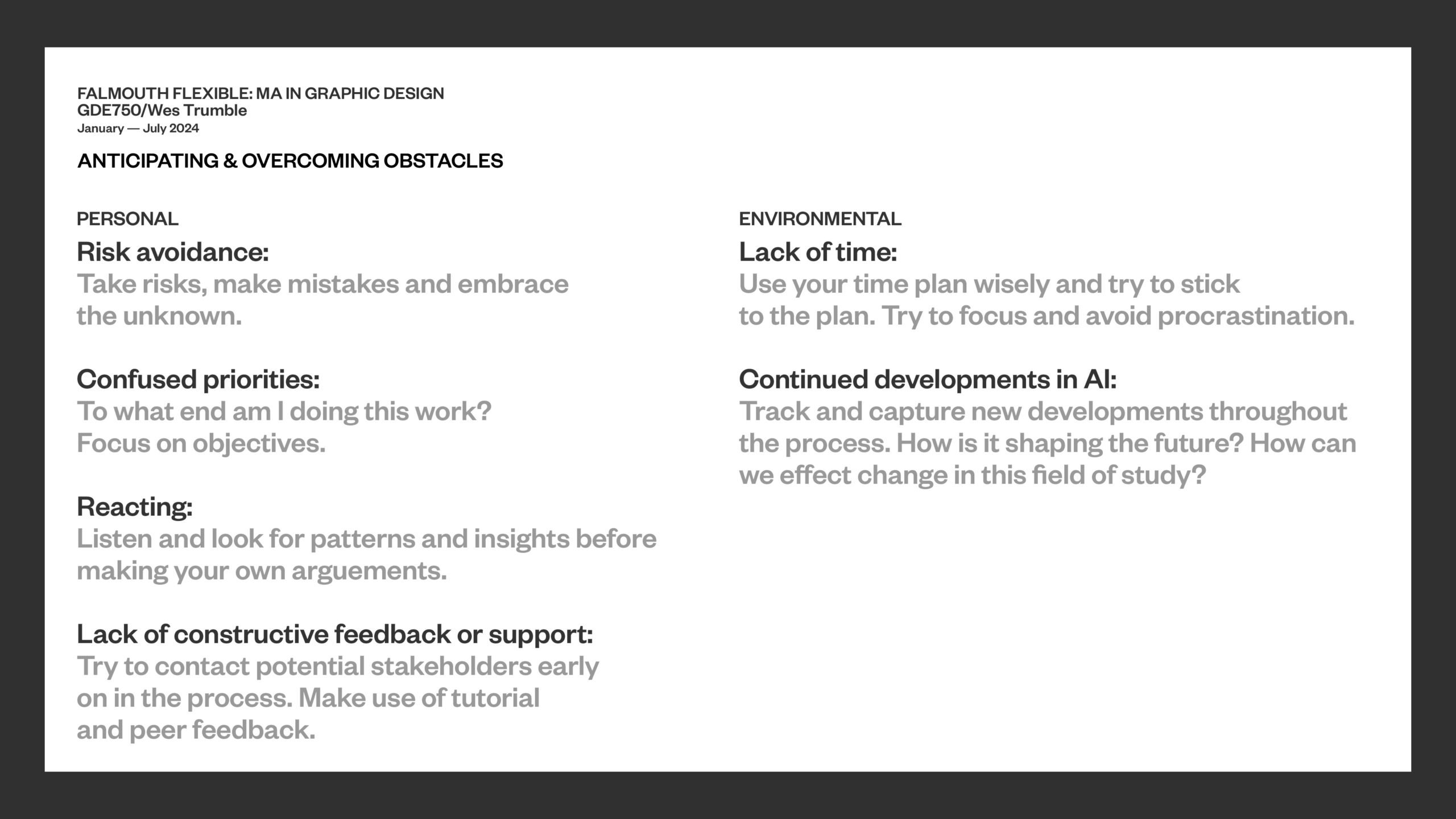

...

